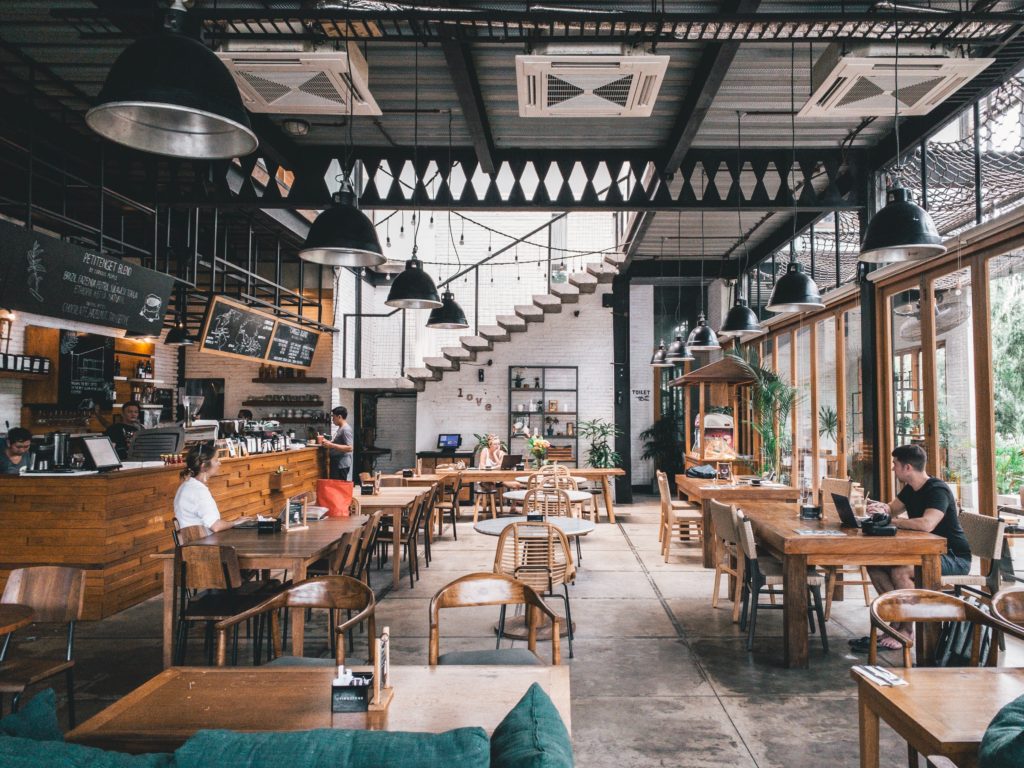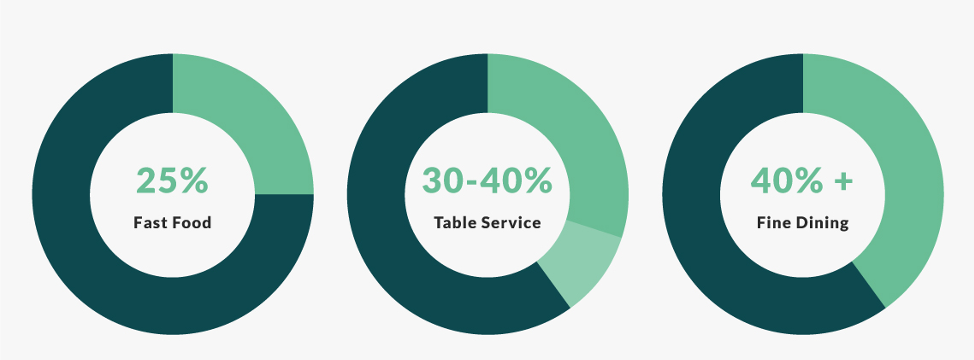Restaurant labor cost is usually the largest cost of owning a restaurant.
Restaurant owners commonly aim to keep labor costs between 20 and 30 percent of the gross income.
A full-service, white-tablecloth restaurant, however, is likely to have a higher labor cost percentage comparing to a casual dining restaurant, as they employ more staff to provide a higher service level.
So how do you regulate the restaurant labor cost?
Okay, there is no sure, 100 percent correct way to handle labor costs in a restaurant because every bar, restaurant, and coffee shop is different.
And this means that every single place has a specific restaurant labor cost situation that will need to be handled differently.
Having said that, in this article, we will disclose a few basic tips and tricks for both calculating and managing restaurant labor costs.
Moreover, we will introduce the restaurant labor cost formula.
Before anything, let us first discuss what is restaurant labor cost, and then move on to calculating the most decent labor cost percentage at a restaurant business and the restaurant labor cost formula.

What is the restaurant labor cost and how to calculate it?
It may surprise new restaurateurs to learn that the labor cost includes more than just hourly wages. Here are some other things factoring in your calculation of labor costs:
- Salaried worker wages
- Hourly worker wages
- Bonuses
- Overtime
- Payroll Taxes
- Health care
- Vacation and sick days
Basically, anything you can categorize as “labor-related” goes into your calculation of the percentage of labor costs.
The labor cost percentage of your restaurant is the overall amount of money you spend on labor costs — including wages, salaries, healthcare, benefits, and taxes — shown as a percentage of food sales.
So, to calculate this figure, we are going to want to start by adding all the associated labor costs for a given period.
Look at the last 30 days, month, quarter or year and add up all the costs that went into paying employees.
Here it is in your best interest to be as vigilant as possible, as we always suggest when it comes to costs, you are easier to overestimate somewhat compared to when you underestimate.

Then, add up all of your total food sales for that same time period.
Divide these two figures into one percentage and multiply by 100 to calculate the amount of labor cost percentage.

Let’s try this out with an example, for the sake of clarity.
Say you have been looking at your books over the past 30 days, and see that you have spent a total of $5,000 on wages and other salary costs.
And, you hit $25,000 in food sales in that same period.
Then our calculation would look like this: percentage of labor costs = ($5,000/$25,000) * 100. That’s 20%.
In other words, 20 percent of your gross income went to the staff in your restaurant.
So, in context, what does that number mean — and why does it matter to your restaurant operations?
What makes the restaurant labor cost such an important metric?
Since labor costs can easily be one of the highest costs associated with running a restaurant, closer monitoring of this metric is critical.
The ability of a restaurant to turn a profit will hinge on something as simple as planning a slow night with an extra member of staff.
Considering the notoriously razor-thin margins for most restaurants, holding your labor costs in check can affect your profitability immediately and enormously.
Plus, electricity is often one of the easiest costs.
Although you may not be able to reduce the cost of food or lower your building lease, you may be able to keep your staff as lean as possible (without compromising quality, of course!) and monitor closely how many people should be working at any given shift.
We are going to get into some practical suggestions early, but first, let’s look at how much labor costs various restaurants should have to pay.
The average restaurant labor cost
Assuming that different types of restaurants have different labor needs and therefore different prices.
Here you can see these averages for each type of restaurant:

All of those costs are unpredictable, and should not be treated as set in stone rules.
Nevertheless, they will provide recommendations for seeing if your restaurant is hitting near the mark.
If you run a fast-food restaurant with labor costs that reach 40 percent of your revenue, you might be able to make some changes to reduce that expense.
The most important thing here is to set a target and use that as a benchmark for the overall results and financial performance of your restaurant.
You may set a goal to keep your labor cost percentage below, say, 30%, and build on that number a monthly or quarterly budget.
Then assess how well you have performed, and make adjustments when required.
It may become clear that you are running consistently at 35 percent instead of 30 percent, which means that you will probably need to make adjustments elsewhere to maintain profitability.
This is a delicate balancing act that all begins by carefully calculating and evaluating the costs.
Average Labor Costs By Restaurant Type
Sure, now that you have covered all of the basics, it’s time to look at some estimates of restaurant labor costs based on different types of restaurants.
Now that you know how individualized labor costs are at each restaurant, you should, however, keep that in mind when you interpret these averages to get a feeling (just a sense) of whether you are in the right ballpark or not:
- Restaurants with fast food: 25 percent. “Many fast-food restaurants can reach labor costs as low as 25 percent,” as Chron notes, but that doesn’t mean labor costs cannot (or should not) run higher. Which makes sense, if you think about it. Food moves faster, profit margins are higher, and labor is fairly unspecialized, ensuring that delivery costs less.
- Restaurants with table service: 30-40 percent. Specific restaurants fall within this spectrum depending on “the menu and robust service,” Chron reports. Costs of food (including drinks) for restaurants typically range from 28% to 35%, depending on restaurant-style and sales mix.
- Fine dining: Varies but appears to the higher end of the scale of 30-40 percent or beyond. As Restaurant Business says, “a fine restaurant with many ingredients on the plate, bread, pastries, pasta, and other in-house items will have a much higher labor cost than a steakhouse that sells high-end yet relatively simple food such as fish, baked potato, and flourless chocolate cake with thaw-and-serve.
What is a decent restaurant labor cost percentage to aim for?
What percentage of labor costs should there be at a restaurant?
Sadly, there is no easy answer to that question. As we saw in the above paragraph, each restaurant is different and has diverse needs for labor.
As we mentioned earlier, as a general rule of thumb, any restaurant should aim at keeping labor costs at around 20 to 30 percent of sales.
However, that number may be lower for some restaurants and higher for others.
Casual businesses, such as counter-service cafes or fast-food restaurants, also often require and even offer lower labor wages.
But a fine-dining restaurant will need to spend more on wages because the demands on workers of that service are so much higher.
Fine-dining staff often require special skills, experience, and talent to deliver the best service, and at the same time, expect to be paid accordingly.
As always, when you are considering big decisions for a restaurant, ask yourself what your guests expect from and love about you.
How to calculate restaurant labor costs?
1. Put your staff into groups
For greater clarity, the first step in forecasting and calculating restaurant labor cost is to group your restaurant labor teams together.
Dividing staff into groups indicates which positions cost you the most. Assign front-of-house personnel, such as servers, hosts, and bartenders to one group.
Another natural group is kitchen staff such as cooks and dishwashers, as are the management staff.
You can also divide your employees by whether they are paid hourly wages or salaries.
As soon as you have your workers divided up, you can compare what each team will cost you.
Meanwhile, you can see if you can tinker with the staff mix you schedule during each shift to reduce the labor costs of your restaurant.
If the bartenders are significantly more expensive than the servers, try to replace one bartender with two servers.
If the required tasks are still covered and the night goes off without any obstacles, you have already found a way to cut your labor costs.
2. Calculate Prime
Now after grouping your staff into respective categories, you will need to recognize and measure the prime cost using a formula for restaurant labor cost.
Be aware that there is going to be a little bit of mathematic ahead. We will be talking about the labor cost formula, but surely that is absolutely nothing to worry about, this is just a simple mathematic process that you can easily handle.
While it might sound scary and overwhelming to measure something called prime cost, it is easier than you might think, and it will tell you a lot about the labor costs of your restaurant!
The prime cost of your business is the sum of your labor costs plus the costs of selling goods, or COGS in short.

COGS = the expense of producing every food and drink item on your menu
After that, you need to combine this number with the labor costs, to arrive at your prime cost.

This number gives you a good picture of the overall cost of keeping the restaurant staffed, serving guests and preparing the food you sell. (But remember, this is not all your expenses — it does not include overheads like rent, utilities, marketing, etc.)
After that, in order to calculate your prime cost percentage, you must do the following equation:

To ensure the profitability of your restaurant, your prime cost should be around 55-60 percent of your sales.
How much of that is COGS versus labor costs can vary, and it can fluctuate over time depending on the needs of your restaurant and external factors such as seasonal food costs or staffing requirements.
But keeping your prime cost below 60 percent is a good benchmark for creating a budget for COGS and labor costs.
Saving on restaurant labor cost by training and considerate schedule
Any restaurant owner must use labor scheduling and time and attendance systems to ensure top-level visibility and to be able to identify the possibility of workers going into overtime before it is too late.
These systems can also point out that if you pair the system with a quick inspection of how your staff starts their shifts, your employees tend to clock in early or dilly around before they actually get into work.
Try to turn the data into visual reports, such as graphs, that are an efficient way to quickly analyze multiple data sets at once — and, crucially, recognize outliers.
Invest in training the employees and they are less likely to leave and are going to be more successful while they are employed.
And respected workers on a road to professional growth, will not dissect you for any other restaurant that does not provide such services.
What if the restaurant labor cost is much higher than you expected?
If you find that your labor costs are too high relative to your weekly sales (i.e. on a regular basis over 30 percent), it is probably time to take a hard look at your workers.
You may be scheduling too many workers per shift, or missing opportunities to control costs in three key areas: recruiting training and incentives for career development.
Furthermore, remind the hourly staff to make sure that they are not clocking in sooner than 15 minutes before their shift, and they are clocking out when their shift is really over, not 15 minutes later when they are ready to leave all their things.
It probably does not seem like much to pay a single employee for an extra 15 minutes, but charging each one of your workers for an extra 15 minutes each day can add up to hundreds of dollars very quickly.
Just be aware: some states require employers to pay for “set-up” hourly staff, especially when uniforms or other procedures for shift changes are required, as well as prohibit employees from clocking out for breaks and mealtimes.
For more detailed information please consult your local laws and/or your attorney.
How to manage and control restaurant labor cost
Holding food and labor costs in line is important to the success of a restaurant.
Food inventory should not surpass 28 to 30 percent of its gross revenue for a restaurant to remain profitable, while labor costs will fall anywhere between 22 and 45 percent.
How much the expenses would ultimately depend on the type of restaurant you are running as well as the location of it.
It is time to act when those costs start to rise without a similar increase in revenue.
Downsizing your staff or buying foods of lesser quality may seem like simple solutions, but they are not necessarily the best.
1. Staff Your Business Appropriately
Build a monthly budget for your staffing needs by taking a percentage of your revenue from historical or forecasted revenues.
Although your labor costs should not exceed 45 percent, many small restaurants try to keep their costs below 20 percent.
Instead of setting your employees a fixed weekly schedule, create flexible schedules designed to keep you within your set and predefined budget.
Your timetables will show any business changes due to seasonality, marketing strategies or holidays.
Do not be afraid to send some employees home on days when business becomes unexpectedly slow and the revenues generated may not cover your operating costs.

2. Cross train Your Related Job Staff
Increase the productivity of your staff by cross training them into related job functions.
For example, your prep-cooks should be able to handle the grill or saute station.
Hostesses and servers should know how to perform each other’s job duties and when the service gets busy, busboys should be able to run food to tables.
A cross trained staff may more frequently lead to employees switching shifts.
Carefully monitor these requests as it can lead to many overtime hours worked by some employees which can quickly deplete your budget.
3. Manage waste and spoilage at the kitchen
The increasing cost of food is often associated with in-kitchen waste.
The most common practice leading to waste is improper storage and handling of food, failing to accurately measure portion sizes, preparing large amounts of food in advance, and buying too much inventory.
Spend time educating and tracking the kitchen staff, paying special attention to what is in the garbage pails in the kitchen, and you will be well on your way to maintaining track of your food costs.
4. Manage the Relationships with the Providers
One of the biggest mistakes a restaurant owner can make is taking suppliers for granted when it comes to food costs.
No matter how long you have been with business, take the time to count and weigh food as it comes in the door to make sure you get what you are paying for.
Talk to your suppliers about reducing your costs and let them know that you will receive quotes from competitors to ensure that your business gets the best deals.
If you can make quick changes to your menu, ask your suppliers to let you know that they can sell you at a reduced cost when they have excess inventories.
Build relationships with local farmers as their goods, without the middleman, are fresher and often cheaper.
How to effectively lower the restaurant labor cost?
The answer is not always to pay less to your employees or to schedule fewer shifts.
Here are just a few creative ways in which restaurants lower labor costs:
- Pay an employee when they are supposed to start, rather than when they arrive. Clock-in strengthening is a feature of many point-of-sale systems, including toasting.
- Provide bonuses for reducing absenteeism.
- Be mindful of rules relating to overtime. Many states require employers to pay employees who work over 40 hours in a given workweek for time-and-a-half or even double-time. Hire and schedule enough staff to avoid the cost of the overtime.
- Keep an up-to-date tally of how many hours your employees actually worked, as opposed to how many they were planned. Thus, you can spot potential offenders overtime before it turns into a problem.
- Cross train and turn the workers into the jack of all trades. For example, when a server goes home on a sick leave, if your hostess can step in, she can keep the diners happy without adding extra payroll.
- Schedule employees willing to make a split shift so you are staffed at the right time.
- Prepare your schedule with scheduling apps such as 7shifts, HotSchedules, and TSheets ahead of time — weekly, if necessary.
- Go paperless. Remove repetitive pen and paper procedures with items specifically designed for restaurant payroll, from the payroll and labor management processes.
Conclusion
Controlling food costs is an important component of ensuring that your foodservice business is successful.
Although, food costs are just a part of the picture. Labor costs must also be controlled and labor demands must be predicted accurately if your business is aimed to succeed.
If you have more personnel than you need, your labor costs will be too high, and the company will lose money.
If you have insufficient personnel for a given period of time, customer service would suffer.
Your goal in managing staffing and scheduling needs is to balance labor supply with customer demand so that you can deliver quality service at no unnecessary expense.
The food industry is labor-intensive. Technology has not replaced humans with machines (although some foodservice operations experiment with robots that cook and assist in service.)
Unlike an automotive manufacturing plant, a restaurant can not store the product until tomorrow or the day after if customers do not buy it today.
The same seat can only be sold a fixed number of times in the restaurant, based on operating hours and number of turns (customer turnover rate).
It is therefore important to be able to predict the number of customers you will have, the peak demand times and the resources required to provide these customers with a service.


